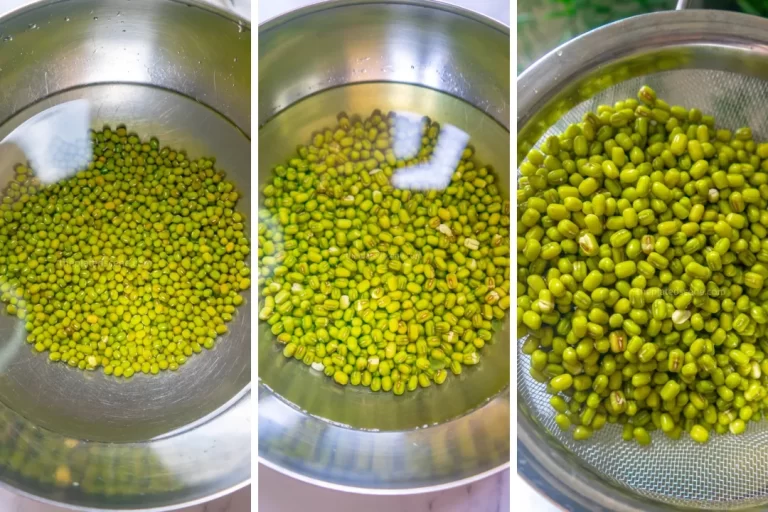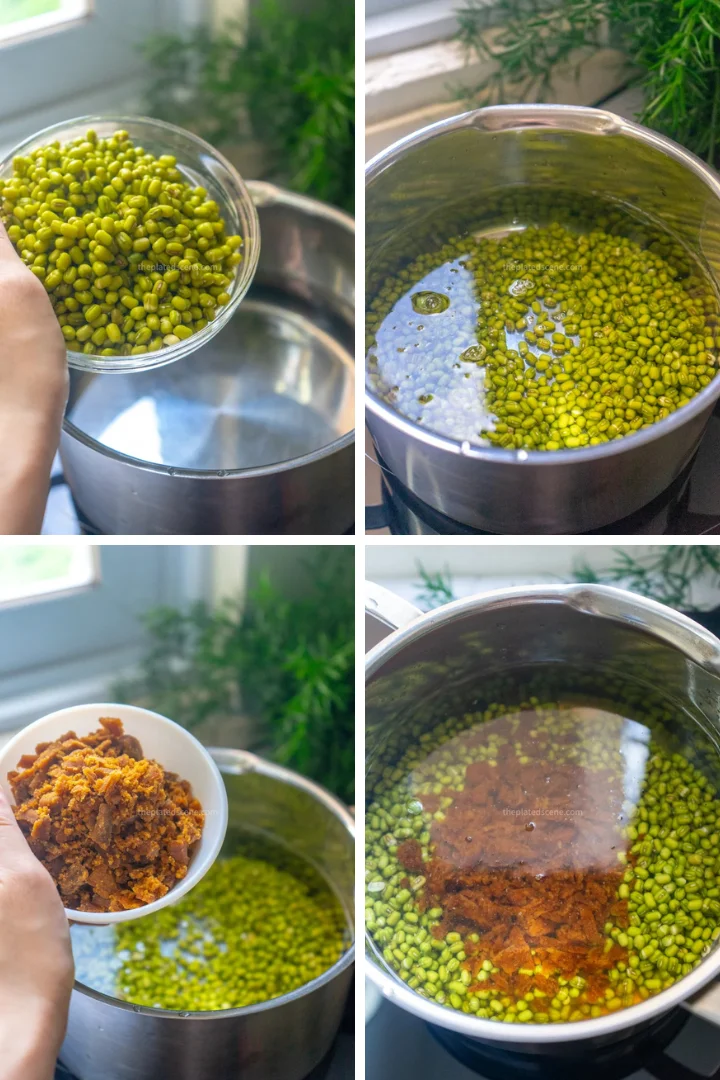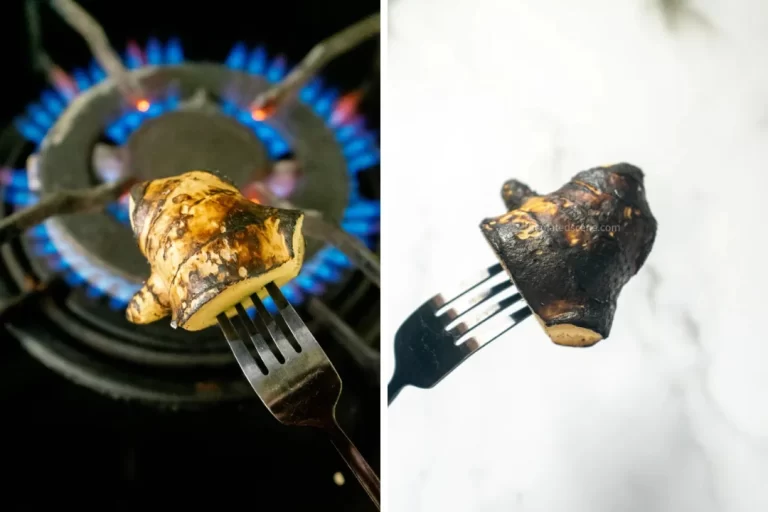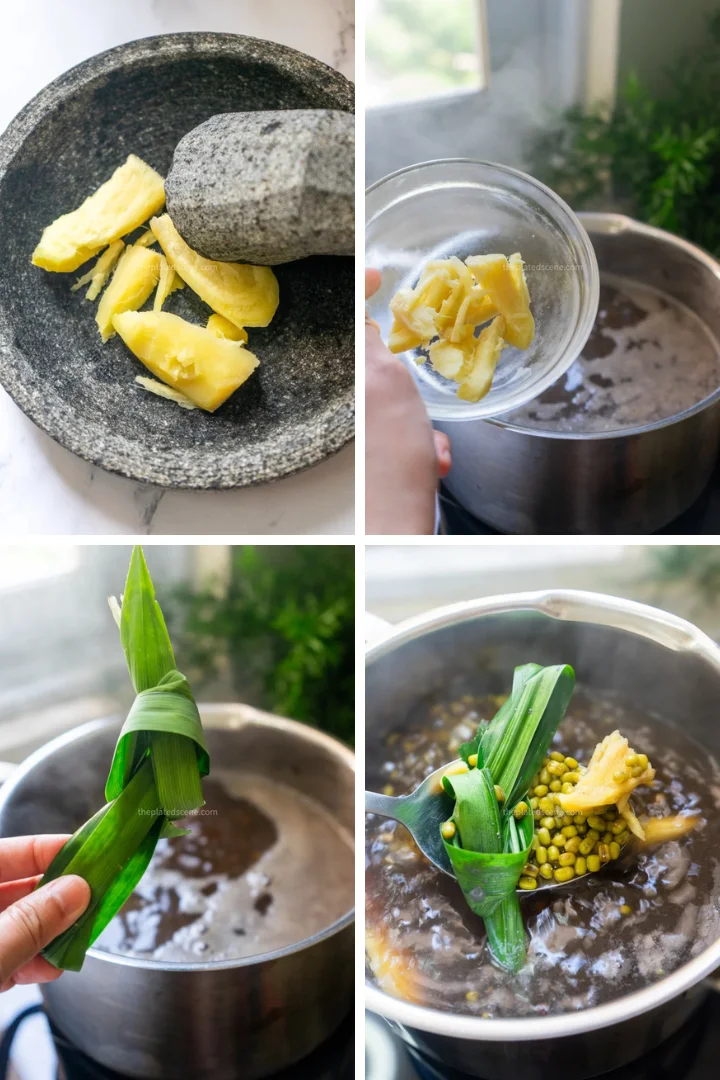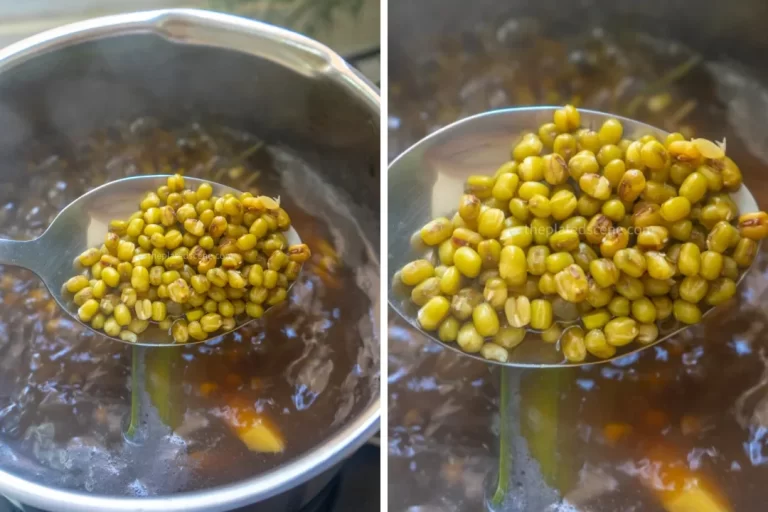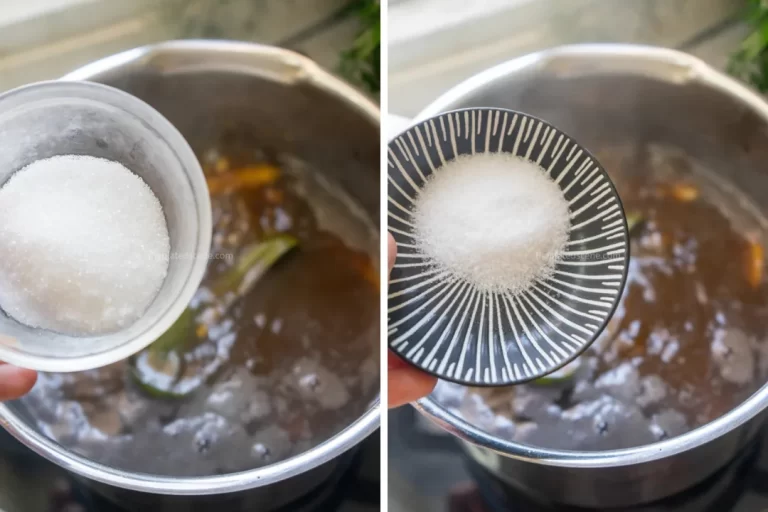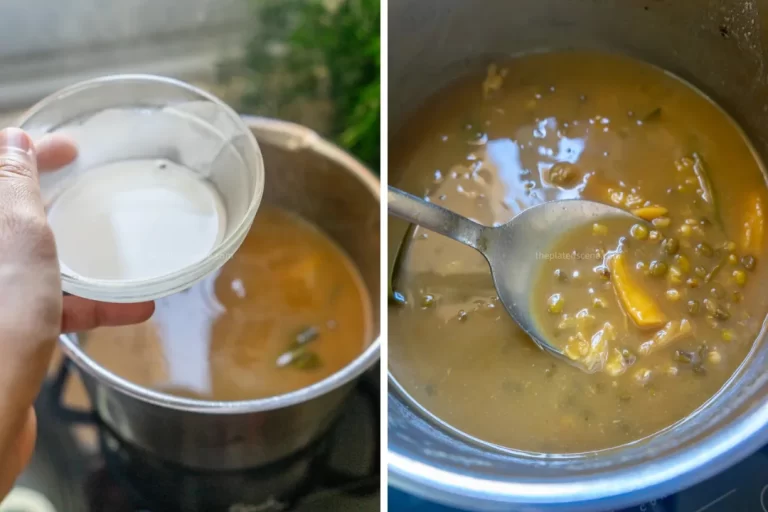Growing up in Indonesia, few things felt as comforting as a bowl of bubur kacang ijo on a rainy afternoon. My mother would often prepare this sweet mung bean porridge, filling the kitchen with the aroma of simmering coconut milk and pandan leaves. It was a humble dessert yet rich in flavor, texture, and nostalgia. Now, as I share this recipe on this site, I’m transported back to those cozy moments, hoping to bring the same warmth to your kitchen with this bubur kacang ijo recipe.
Table of Contents
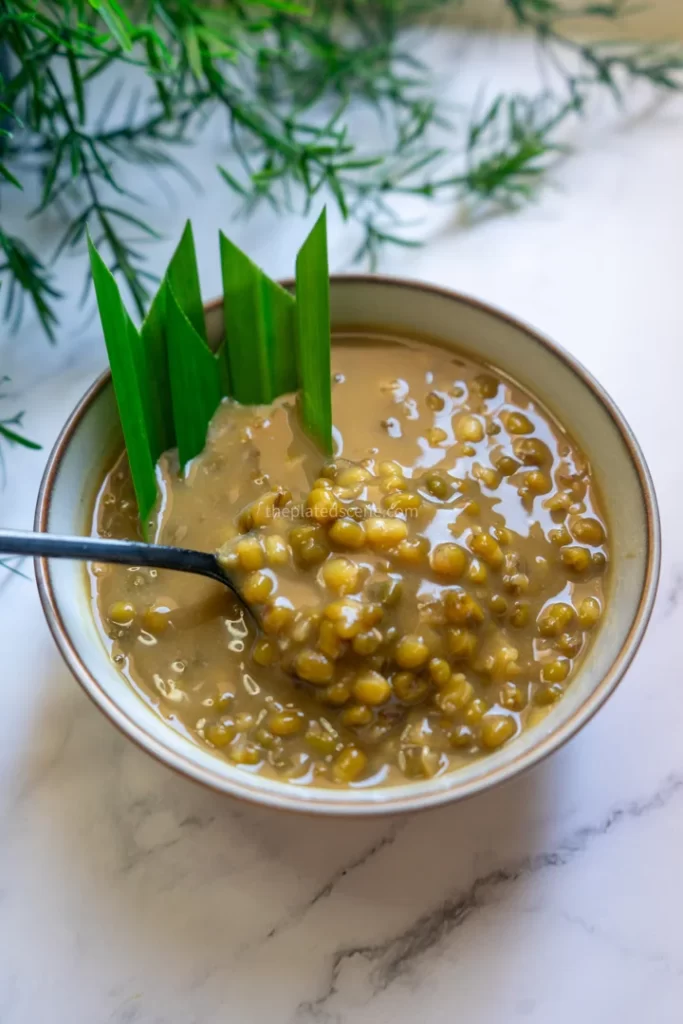
History of Bubur Kacang Ijo
Bubur kacang ijo is more than just a dessert; it’s an essential part of Indonesian culinary culture. Originating from Java, this sweet mung bean porridge has a history intertwined with Indonesia’s agricultural roots. Mung beans, known locally as kacang hijau, have been cultivated for centuries due to their resilience in tropical climates and nutritional benefits. The combination of mung beans, coconut milk, and palm sugar in bubur kacang ijo reflects Indonesia’s abundant natural resources and the creativity of its people in turning simple ingredients into delightful dishes.
Bubur kacang ijo is often enjoyed as a breakfast dish, afternoon snack, or dessert, and its popularity extends beyond Java to every corner of Indonesia. The dish has also gained recognition in neighboring Southeast Asian countries, each with its unique twist, but the essence of bubur kacang ijo remains unmistakably Indonesian.
The Concept of Burjo
In Indonesia, especially in cities like Yogyakarta and Bandung, you’ll find small eateries known as Warung Burjo—short for Bubur Kacang Ijo. These humble food stalls, often run by Javanese families, serve affordable comfort food, with bubur kacang ijo as their signature dish. Over time, Warung Burjo became more than just dessert spots; they evolved into popular hangouts for students and workers, offering a variety of budget-friendly meals, including instant noodles, fried rice, and, of course, bubur kacang ijo.
The concept of Burjo is deeply rooted in Indonesian student culture. It provides an accessible and comforting meal for those away from home. The simplicity and affordability of bubur kacang ijo make it a staple in these eateries, symbolizing warmth, comfort, and community.
Why Do We Need to Soak the Mung Bean Overnight?
One of the essential steps in making bubur kacang ijo is soaking the mung beans overnight. This process softens the beans, ensuring they cook evenly and quickly the next day. Soaking also helps break down complex sugars, making the beans easier to digest. Skipping this step might leave you with hard, unevenly cooked beans and a longer cooking time. So, while it might seem like an extra step, soaking overnight is key to achieving that creamy, melt-in-your-mouth texture that makes bubur kacang ijo so delightful.

Nutritional Benefits of Mung Beans
Mung beans, the star ingredient of bubur kacang ijo, are a powerhouse of nutrition. Rich in plant-based protein, mung beans provide essential amino acids that support muscle repair and overall health. They are also an excellent source of dietary fiber, promoting healthy digestion and keeping you full longer.
Bubur kacang ijo is not just a tasty treat but also a nutritious one. Mung beans are packed with vitamins and minerals such as folate, magnesium, potassium, and iron, contributing to better heart health, stable blood sugar levels, and improved energy levels. Additionally, mung beans are known for their antioxidant properties, which help reduce inflammation and promote overall well-being. Enjoying a bowl of bubur kacang ijo means savoring a dish that is as healthy as it is delicious.
For detailed article, please read 10 Impressive Health Benefits of Mung Bean.
How Bubur Kacang Ijo Tastes Like
Bubur kacang ijo offers a delightful combination of flavors and textures. The mung beans provide a subtle nuttiness, softened to perfection in the cooking process. Coconut milk adds a rich creaminess, while gula jawa brings a deep caramel-like sweetness. Pandan leaves infuse the porridge with a fragrant, almost vanilla-like aroma. Every spoonful is a balance of sweet, creamy, and earthy flavors, making bubur kacang ijo a dessert that feels both indulgent and wholesome.
Old Ginger vs. Young Ginger
Ginger plays an important role in bubur kacang ijo, offering a hint of warmth and spice that cuts through the sweetness. But what type of ginger should you use?
• Old Ginger: Known for its fibrous texture and intense, spicy flavor, old ginger adds a strong, punchy heat to the porridge. It’s perfect if you prefer a more robust ginger kick in your bubur kacang ijo.
• Young Ginger: Milder and juicier, young ginger offers a more subtle warmth and is easier to slice and cook with. It’s ideal if you want just a hint of ginger without overpowering the dessert.
Personally, I prefer using old ginger for its boldness, but if you’re new to using ginger in desserts, young ginger is a great starting point.
Why Do We Need to Burn the Ginger?
You might wonder why this recipe call for burning or charring the ginger before adding it to the bubur kacang ijo. Burning ginger intensifies its flavor, adding a smoky, caramelized note that complements the sweetness of the dessert. This step also mows out raw ginger’s sharpness, giving you a deeper, more complex flavor profile. While not mandatory, burning the ginger adds a unique touch that elevates your bubur kacang ijo.
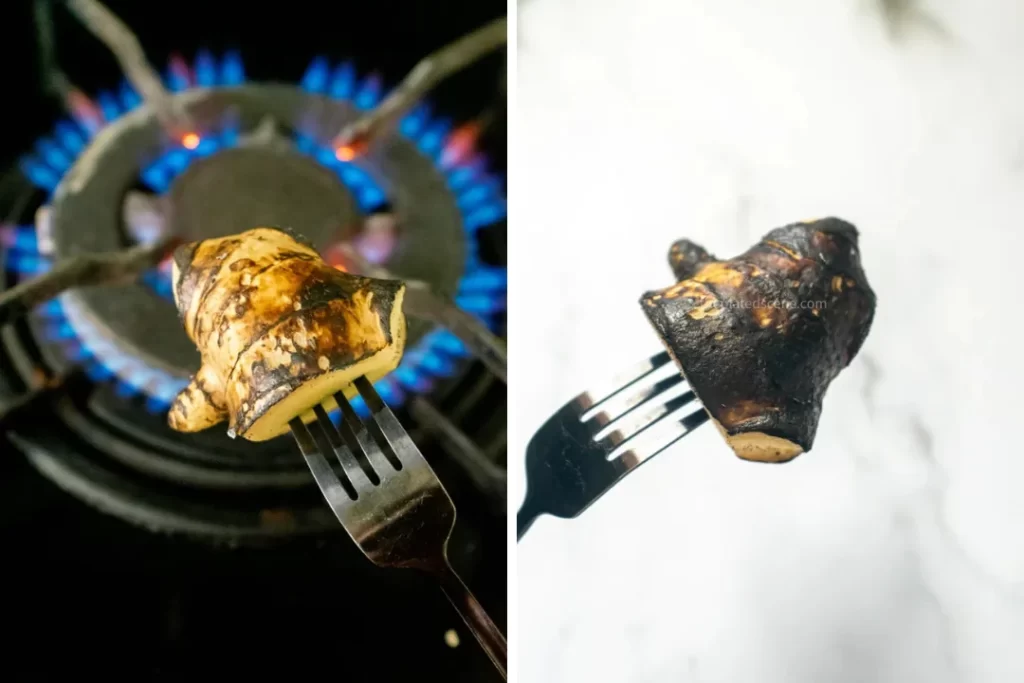
What is Pandan Leave?
No bubur kacang ijo is complete without the fragrant touch of pandan leaves. Often referred to as “Asian vanilla,” pandan is a tropical plant used extensively in Southeast Asian cooking. Its long, slender leaves are tied into knots and simmered in liquids to impart a sweet, floral aroma. In bubur kacang ijo, pandan leaves infuse the coconut milk with a distinct fragrance, making the dessert even more irresistible.
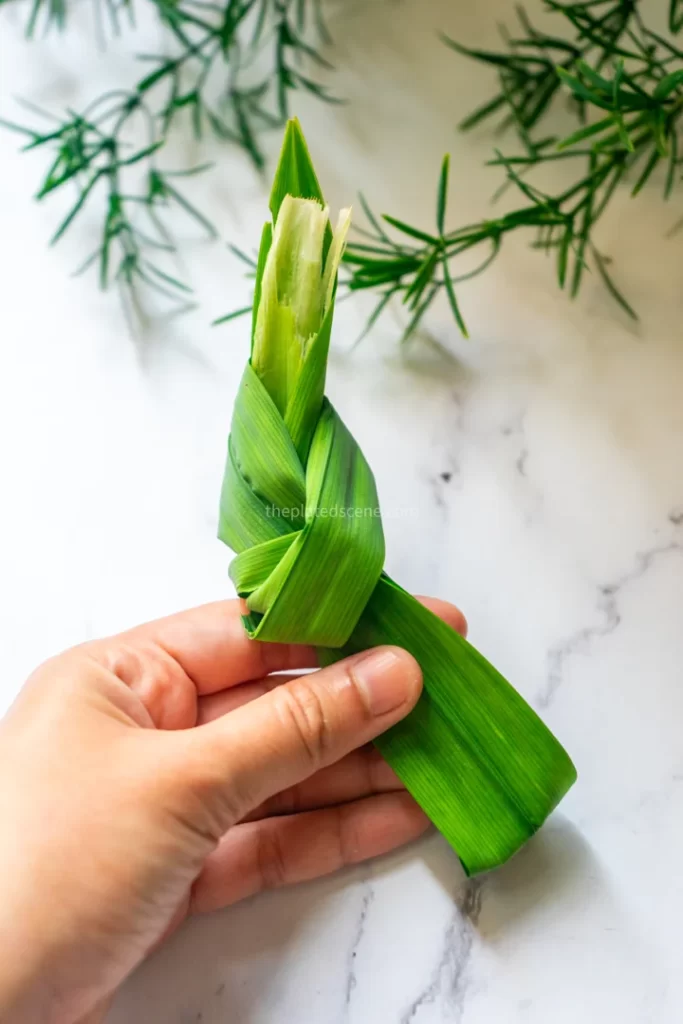
If pandan leaves are unavailable, you can use the following substitutes:
- Vanilla extract: Adds a similar sweet aroma, though lacking the distinct grassy notes of pandan.
- Bay leaves with a pinch of sugar: An unconventional but effective combination that mimics pandan’s earthy sweetness.
- Pandan essence: Available in some Asian grocery stores, providing an artificial but close approximation to fresh pandan leaves.
While none of these replacements can fully replicate the unique flavor of pandan, they can still enhance your bubur kacang ijo when pandan is not an option.
Variation of Bubur Kacang Ijo
While the classic bubur kacang ijo remains a favorite, there are several variations across Indonesia:
- Bubur Kacang Ijo with Black Glutinous Rice: This version, known as bubur kacang ijo ketan hitam, combines mung beans with black glutinous rice, adding a chewy texture and a slightly nutty flavor.
- Bubur Kacang Ijo with Durian: In some regions, durian, the “king of fruits,” is added for a bold, creamy twist.
- Bubur Kacang Ijo with Tapioca Pearls: Some versions include chewy tapioca pearls for a more pudding-like texture.
- Vegan Bubur Kacang Ijo: For a vegan-friendly dessert, substitute palm sugar with coconut sugar and ensure your coconut milk is free from additives.
Each variation offers a unique experience, but the heart of the dish remains the same—comforting, sweet, and satisfying.
Things to Watch Out When Cooking Bubur Kacang Ijo
Making bubur kacang ijo might seem straightforward, but a few tips can ensure your porridge turns out perfect every time:
- Don’t Skip Soaking: Soaking the mung beans overnight is crucial for even cooking.
- Use Fresh Coconut Milk: Freshly extracted coconut milk makes a difference. If using canned, opt for high-quality brands with minimal additives.
- Control the Sugar: Add gula jawa gradually, tasting as you go. You can always add more, but you can’t take it away once it’s in.
- Simmer Gently: Avoid vigorously boiling the coconut milk, as it can curdle. Gentle simmering ensures a smooth, creamy texture.
- Don’t Forget the Pandan: Pandan leaves are essential for that authentic aroma. If unavailable, use one of the substitutes mentioned above.
Bubur kacang ijo is a testament to how simple ingredients can create something truly magical. Whether you’re reminiscing about your Indonesian roots or trying it for the first time, this dessert promises comfort in every spoonful. Ready to make your own? Let’s dive into the recipe next!
Key Ingredients for Bubur Kacang Ijo
Each ingredient in bubur kacang ijo plays an important role in creating the perfect balance of flavors and textures. From the earthy mung beans to the fragrant pandan leaves, here’s a closer look at what makes this traditional Indonesian dessert so special:
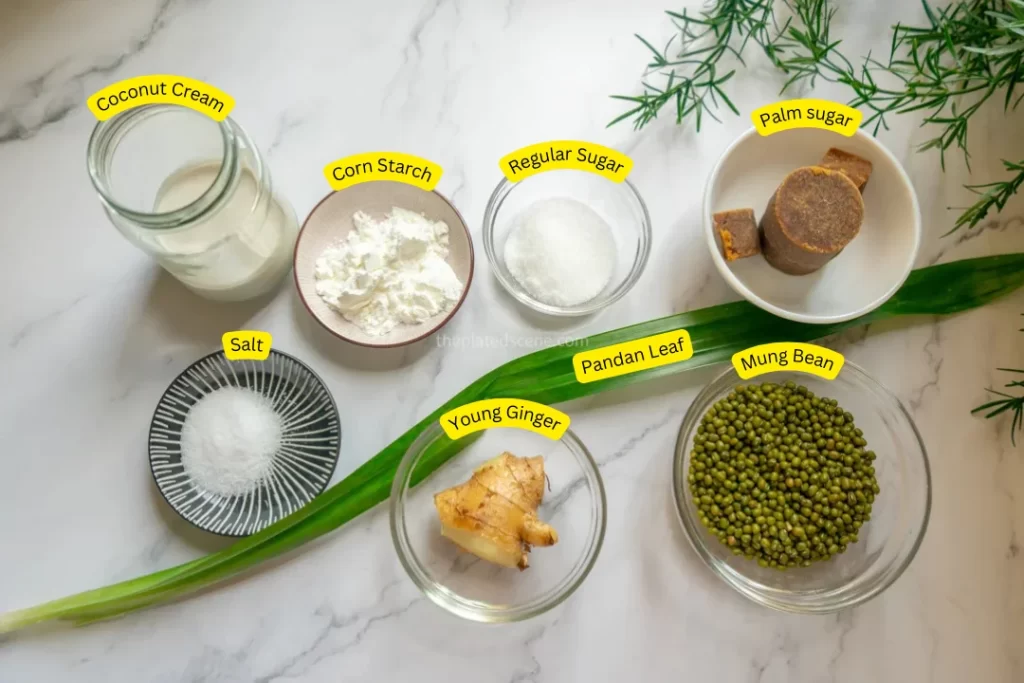
- Mung Beans: The heart of bubur kacang ijo, mung beans provide a subtle nutty flavor and a tender texture when cooked. They are also packed with protein, fiber, and essential nutrients, making the dessert both delicious and nourishing.
- Coconut Cream: This adds a luxurious creaminess to the porridge, giving bubur kacang ijo its signature rich and velvety texture. It also balances the sweetness with its mild, nutty flavor.
- Palm Sugar is a traditional sweetener in Indonesian cuisine. It offers a deep caramel-like sweetness that enhances the overall flavor of the dessert. Palm sugar dissolves into the porridge, adding complexity and richness.
- Sugar: Regular sugar provides an additional layer of sweetness, ensuring that the dessert has the perfect balance without overpowering the other flavors.
- Corn Starch (Optional): As a thickening agent, corn starch gives bubur kacang ijo a smoother, more pudding-like consistency if you prefer a thicker porridge.
- Water: Essential for cooking the mung beans until they are soft and tender, water also helps blend all the ingredients into a cohesive, flavorful dessert.
- Ginger (Burned and Smashed): Burning the ginger intensifies its flavor, adding a warm, spicy note that complements the sweetness of the porridge and provides a subtle depth to the dish.
- Pandan Leaf (Tied into a Knot): Often called the “Asian vanilla,” pandan leaf infuses the dessert with a sweet, floral aroma that is quintessential in many Southeast Asian desserts, giving bubur kacang ijo its authentic fragrance.
- Salt: A pinch of salt enhances the sweetness, rounds out the flavors, and balances the richness of the coconut cream and palm sugar, making every spoonful more satisfying.
Step-by-Step Guide to Making Bubur Kacang Ijo
1. Soak the mung beans overnight
- Place the mung beans in a large bowl and rinse them under running water 2-3 times until the water runs clear. This removes excess starch and any debris.
- Add enough water to completely submerge the mung beans and let them soak for at least 8 hours, preferably overnight. The beans will absorb water and expand in size.
- Soaking helps soften the beans, reducing the cooking time and ensuring they cook evenly. It also improves digestion by breaking down certain compounds that can cause bloating.
- Tip: If you forget to soak the mung beans overnight, you can use a quick soak method by boiling them for 5 minutes and letting them sit in hot water for 1 hour before draining and continuing with the recipe.

2. Boil the mung beans together with palm sugar
- Drain and rinse the soaked mung beans before transferring them to a pot.
- Add fresh water to the pot and bring it to a boil over 140 degrees on your induction stove (or medium heat on a standard stove).
- Once the water starts simmering, add shredded palm sugar and stir until it dissolves.
- Palm sugar not only sweetens the porridge but also adds a caramel-like depth to the flavor. Adding it at this stage allows it to fully dissolve and infuse into the beans.
- Tip: If your palm sugar comes in a solid block, you can shave or chop it finely before adding it to the pot to help it melt faster.
- Watch out: Stir occasionally to prevent the sugar from sticking to the bottom and burning.
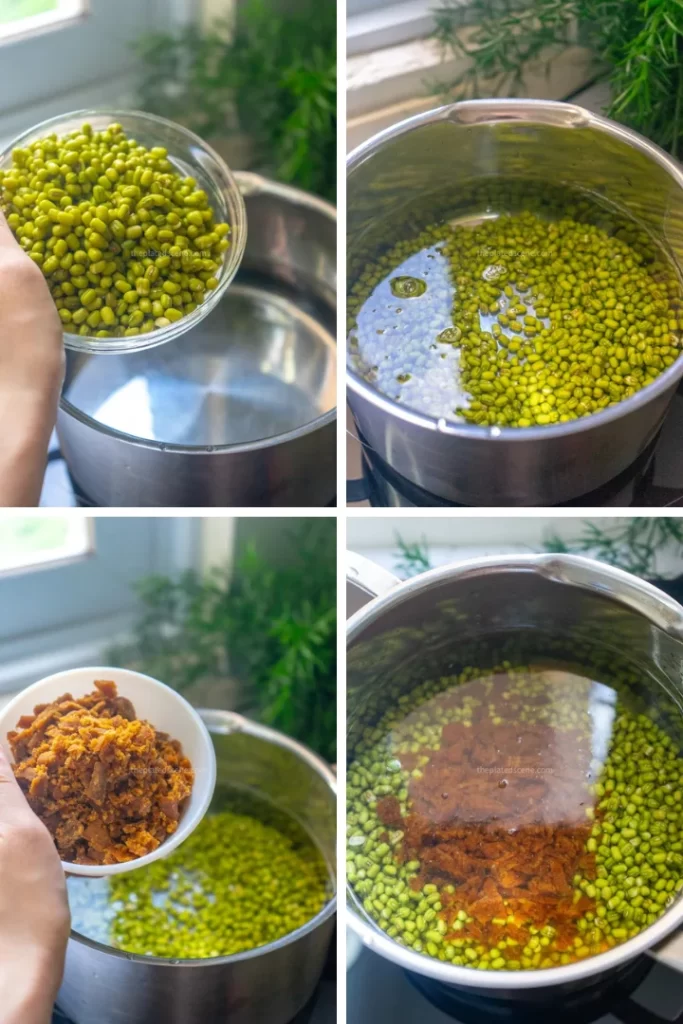

3. Add pandan leaves and ginger after boiling
- Once the mung beans are boiling and the palm sugar has dissolved, add the tied pandan leaves and burned, smashed ginger to the pot.
- The pandan leaves will release their aromatic oils into the liquid, giving the porridge a subtly sweet fragrance.
- Burning the ginger before smashing it enhances its warmth and adds a smoky depth to the dish.
- Tip: To burn the ginger, lightly char it over an open flame or in a dry pan for a few minutes, then smash it before adding it to the pot.
- How to smash the ginger: You can use the back of a knife, a rolling pin, or a mortar and pestle to break it down. Smashing helps release the juices and intensifies the ginger’s flavor.
- Watch out: Keep the pandan leaves tied in a knot to make them easier to remove later.
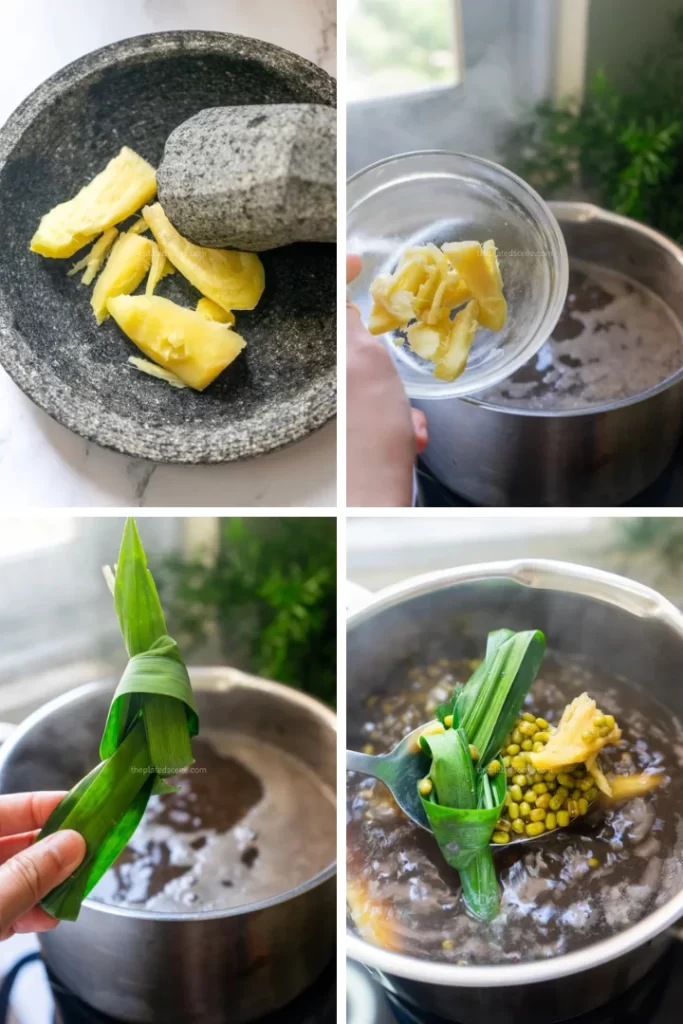
4. Cook until some mung beans split but are not fully broken (10-15 minutes)
- Reduce the heat slightly and let the mixture simmer for 10-15 minutes while stirring occasionally.
- The goal is for some mung beans to soften and split, but not completely break apart. You still want some whole beans for texture.
- Tip: If the water reduces too quickly before the beans are fully cooked, add a little more water as needed.
- Watch out: Don’t stir too vigorously—mung beans are delicate and can turn mushy if over-stirred.
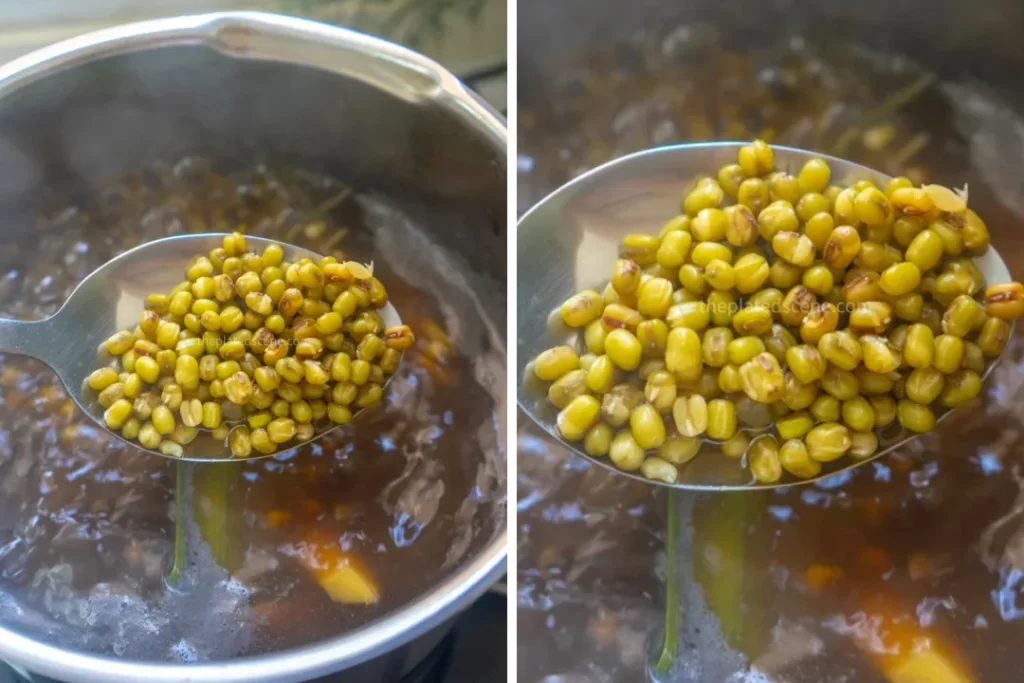
5. Add regular sugar and salt, then mix well
- After the mung beans have softened, add regular white sugar and salt, then stir until fully dissolved.
- Sugar enhances the sweetness and balances out the earthiness of the mung beans, complementing the caramelized palm sugar.
- Salt plays a crucial role in enhancing the overall flavor, making the sweetness more pronounced while balancing the richness of the coconut cream that will be added later.
- Tip: Adjust the sugar to your taste—some prefer a milder sweetness, while others like a richer, more dessert-like flavor.
- Watch out: Always add sugar and salt at this stage, not before, as adding too much sugar early on can cause the mung beans to harden and delay the cooking process.
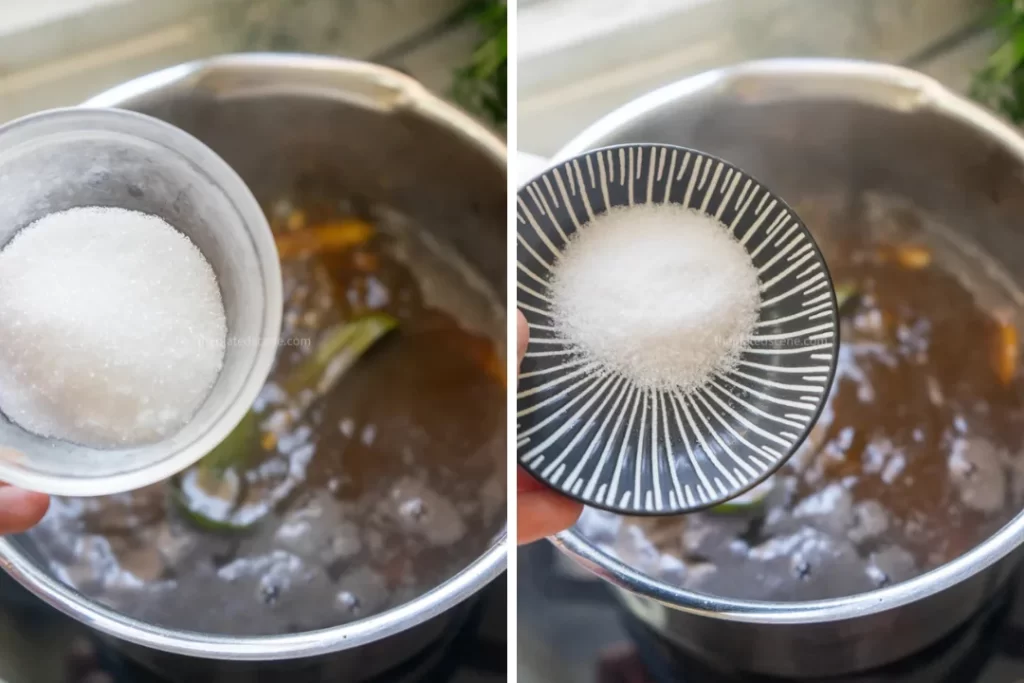
6. Add the coconut cream and continue mixing until boiling again
- Slowly pour in the coconut cream while continuously stirring to prevent separation.
- Keep stirring gently until the mixture returns to a boil—this is crucial to keeping the coconut cream from curdling.
- The coconut cream will make the porridge creamy, velvety, and more indulgent.
- Tip: If using canned coconut cream, shake the can well before opening to mix the thick and watery parts.
- Watch out: Do not cook on high heat, as excessive heat can cause the coconut cream to separate, affecting the texture of the porridge.
7. [Optional] Add the corn starch for a thicker texture
- If you prefer a thicker porridge, dissolve cornstarch in a small amount of water before adding it to the pot.
- Slowly drizzle the cornstarch slurry into the bubbling porridge while stirring continuously to prevent lumps.
- Let it simmer for a few more minutes until the mixture thickens to your liking.
- Tip: Adding cornstarch is a great way to create a more pudding-like consistency, but if you prefer a lighter texture, you can skip this step.
- Watch out: Never add dry cornstarch directly to the porridge—always dissolve it in water first to avoid clumps.
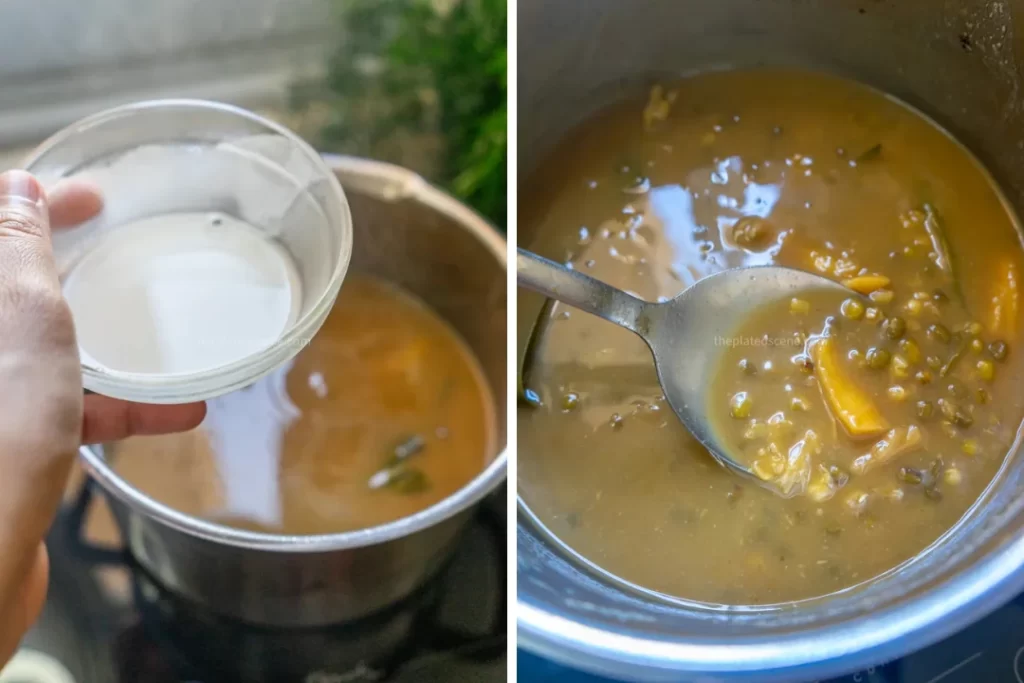
Final Tips for Perfect Bubur Kacang Ijo
✔️ Use an induction setting of 140 degrees for steady, controlled cooking.
✔️ Adjust sweetness to your preference—some prefer bubur kacang ijo mildly sweet, while others like a richer taste.
✔️ Don’t overcook the mung beans—some should remain whole for texture.
✔️ Always stir gently after adding coconut cream to prevent curdling.
✔️ Serve warm or chilled—bubur kacang ijo tastes great both ways!
With these detailed steps, you’ll be able to create a perfect bowl of bubur kacang ijo every time. Let me know if you need more details or additional tips!
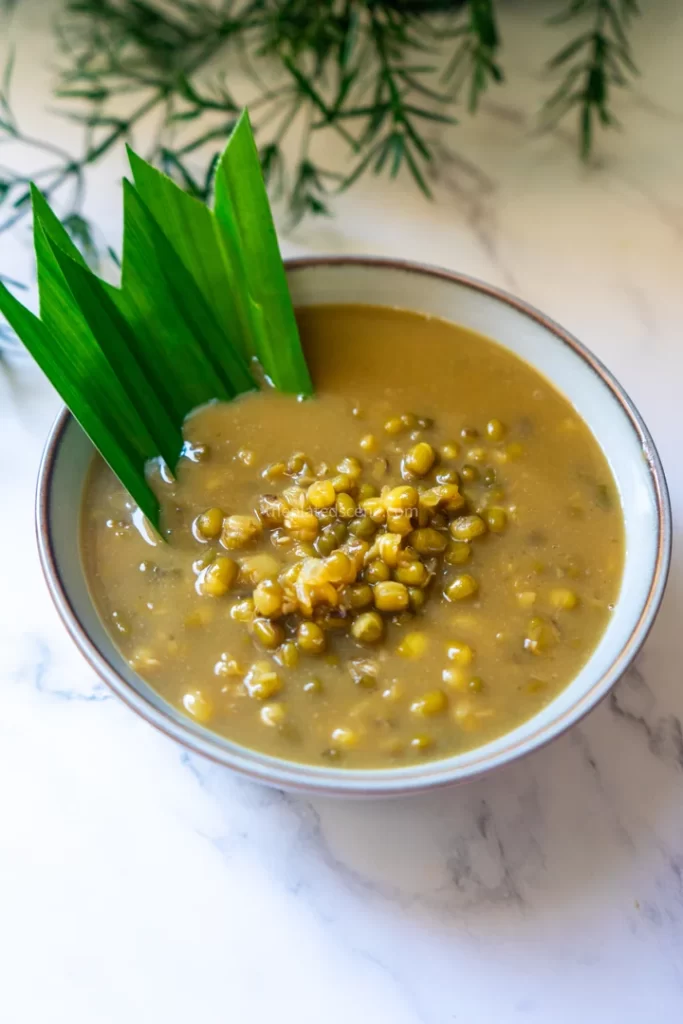
Other Recipes You Might Like on The Plated Scene
If you enjoyed making bubur kacang ijo, here are more delicious Indonesian recipes on The Plated Scene that you might love:
- Ketoprak Jakarta – A refreshing Indonesian salad with rice cakes, vermicelli noodles, tofu, and tempeh, all drizzled with a rich peanut sauce. A perfect blend of textures and flavors!
- Kering Tempe – Sweet and savory crispy tempeh coated in caramelized palm sugar and chili, a popular Indonesian side dish that’s perfect as a snack or a rice companion.
Explore these recipes and dive deeper into the world of Indonesian cuisine — all simple, flavorful, and perfect for sharing! 🌟



